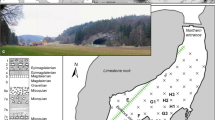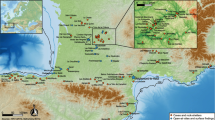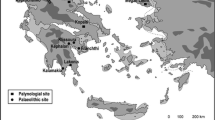Abstract
Kilgii Gwaay is an early Holocene archaeological wet site located in the intertidal zone of Ellen Island in the southern Haida Gwaii archipelago of coastal British Columbia, Canada. The Kilgii site includes one of the oldest shell middens in western North America and provides evidence of early maritime adaptations by humans. Radiocarbon-dated cultural deposits that surround a small palaeopond (Kilgii Pond) include hearth features, abundant lithic, bone and wood artifacts, and a diverse fossil fauna and flora. The known occupation dates between 10,800 and 10,500 cal bp, when relative sea level was 1–3 m lower than today. The site was submerged and capped by marine deposits by 10,500 cal bp as relative sea level rose. We conducted multi-proxy palaeoenvironmental analyses (magnetic susceptibility, pollen, charcoal, macrofossils) on Kilgii Pond sediments from a core taken beneath the coarse intertidal deposits. Pollen analysis indicates establishment of herb–shrub tundra by 14,500 cal bp, followed by pine-dominated communities after 13,800 cal bp and spruce forest with abundant ferns from about 13,250 cal bp. Macroscopic charcoal in the core is most abundant during the period of confirmed human occupation; however, significant peaks in charcoal abundance are present well below the known occupation horizon. Since lightning and natural forest fires are infrequent in this wet hypermaritime setting, we consider that the charcoal peaks from Kilgii Pond may serve as a proxy for human presence, potentially as early as 13,000 cal bp, approximately 2,200 years earlier than indicated by the AMS-dated cultural deposits and artifacts.







Similar content being viewed by others
References
BC Ministry of Forests (2003) Provincial lightning database 1982-2002. BC Ministry of Forests, Victoria
Blaauw M (2010) clam: classical age-depth modelling of cores from deposits. R package v. 2.2
Boyd R (1999) Indians, fire and the land in the Pacific Northwest. Oregon State University Press, Corvallis
Brown RJ, Hebda RJ (2002) Origin, development, and dynamics of coastal temperate conifer rainforests of southern Vancouver Island, Canada. Can J For Res 32:353–372
Carrara PE, Ager TA, Baichtal JF (2007) Possible refugia in the Alexander Archipelago of southeastern Alaska during the late Wisconsin glaciation. Can J Earth Sci 44:229–244
Cohen JM (2014) Paleoethnobotany of Kilgii Gwaay: a 10,700 year old ancestral Haida archaeological wet site. MA thesis, University of Victoria
Darvill CM, Menounos B, Goehring BM, Lian OB, Caffee MW (2018) Retreat of the Western Cordilleran ice sheet margin during the last deglaciation. Geophys Res Lett 45:9,710–9,720
Deur D, Turner NJ (2005) Keeping it living, traditions of plant use and cultivation on the Northwest Coast of North America. University of British Columbia Press, Vancouver
Easton NA (1992) Mal de Mer above Terra Incognita, or, “What ails the coastal migration theory”? Arct Anthropol 29:28–42
Fægri K, Iversen J (1989) In: Fægri K, Kaland PE, Krzywinski K (eds) Textbook of pollen analysis, 4th edn. Wiley, Chichester
Fedje DW (2003) Ancient landscapes and archaeology in Haida Gwaii and Hecate Strait. In: Carlson RL (ed) Archaeology of coastal British Columbia, essays in honour of Professor Philip M Hobler. Archaeology Press, Simon Fraser University, Burnaby, pp 29–38
Fedje DW, Wigen RJ, Mackie Q, Lake CR, Sumpter ID (2001) Preliminary results from investigations at Kilgii Gwaay: an early Holocene archaeological site on Ellen Island, Haida Gwaii, British Columbia. Can J Archaeol 25:98–120
Fedje DW, Josenhans H, Clague J, Barrie V, Archer D, Southon J (2005a) Hecate Strait paleoshorelines. In: Fedje DW, Mathewes RW (eds) Haida Gwaii: Human history and environment from the time of Loon to the time of the iron people. University of British Columbia Press, Vancouver, pp 21–37
Fedje DW, Mackie AP, Wigen RJ, Mackie Q, Lake C (2005b) Kilgii Gwaay: an early maritime site in the south of Haida Gwaii. In: Fedje DW, Mathewes RW (eds) Haida Gwaii: human history and environment from the time of Loon to the time of the iron people. University of British Columbia Press, Vancouver, pp 187–203
Fedje DW, Mackie Q, Lacourse T, McLaren D (2011) Younger Dryas environments and archaeology on the Northwest Coast of North America. Quat Int 242:452–462
Gavin DG, Brubaker LB, Lertzman K (2003) Holocene fire history of a coastal temperate rain forest based on soil charcoal radiocarbon dates. Ecology 84:186–201
Grimm E (2011) TILIA: a pollen program for analysis and display. Illinois State Museum, Springfield. http://www.tiliait.com/
Hebda RJ, Pellatt MG, Mathewes RW, Fedje DW, Acheson S (2005) Vegetation history of Anthony Island, Haida Gwaii, and its relationship to climate change and human settlement. In: Fedje DW, Mathewes RW (eds) Haida Gwaii: human history and environment from the time of Loon to the time of the iron people. University of British Columbia Press, Vancouver, pp 59–76
Helmer EF (2014) Palynology and paleoecology at Kilgii Gwaay archaeological site, southern Haida Gwaii. MSc thesis, Simon Fraser University
Heusser CJ (1995) Late-Quaternary vegetation response to climatic-glacial forcing in North Pacific America. Phys Geogr 16:118–149
Higuera PE, Brubaker LB, Anderson PM, Hu FS, Brown TA (2009) Vegetation mediated the impacts of postglacial climate change on fire regimes in the south-central Brooks Range, Alaska. Ecol Monogr 79:201–219
Hoffman KM, Gavin DG, Lertzman KP, Smith DJ, Starzomski BM (2016a) 13,000 years of fire history derived from soil charcoal in a British Columbia coastal temperate rain forest. Ecosphere 7:e01415
Hoffman KM, Gavin DG, Starzomski BM (2016b) Seven hundred years of human-driven and climate-influenced fire activity in a British Columbia coastal temperate rainforest. R Soc Open Sci 3:160608
Klinka K, Krajina VJ, Ceska A, Scagel AM (1989) Indicator plants of coastal British Columbia. University of British Columbia Press, Vancouver
Lacourse T (2004) A late-Pleistocene pollen record from the continental shelf of western Canada. Curr Res Pleistocene 21:87–89
Lacourse T, Mathewes RW (2005) Terrestrial paleoecology of Haida Gwaii and the continental shelf: vegetation, climate, and plant resources of the coastal migration route. In: Fedje DW, Mathewes RW (eds) Haida Gwaii: human history and environment from the time of Loon to the time of the iron people. University of British Columbia Press, Vancouver, pp 38–58
Lacourse T, Mathewes RW, Fedje DW (2005) Late-glacial vegetation dynamics of the Queen Charlotte Islands and adjacent continental shelf, British Columbia, Canada. Palaeogeogr Palaeoclimatol Palaeoecol 226:36–57
Lacourse T, Delepine JM, Hoffman EH, Mathewes RW (2012) A 14,000 year vegetation history of a hypermaritime island on the outer Pacific coast of Canada based on fossil pollen, spores and conifer stomata. Quat Res 78:572–582
Lertzman KP, Gavin D, Hallett DJ, Brubaker LB, Lepofsky D, Mathewes RW (2002) Long-term fire regime estimated from soil charcoal in coastal temperate rainforests. Conserv Ecol 6(2):5
Lesnek AJ, Briner JP, Lindqvist C, Baichtal JF, Heaton TH (2018) Deglaciation of the Pacific coastal corridor directly preceded the human colonization of the Americas. Sci Adv 4:eaar5040
Mackie Q, Fedje D, McLaren D (2018) Archaeology and sea level change on the British Columbia coast. Can J Archaeol 42:74–91
Mandryk CA, Josenhans H, Fedje DW, Mathewes RW (2001) Late Quaternary paleoenvironments of Northwestern North America: implications for inland versus coastal migration routes. Quat Sci Rev 20:301–314
May L, Lacourse T (2012) Morphological differentiation of Alnus (alder) pollen from western North America. Rev Palaeobot Palynol 180:15–24
McAndrews JH, Berti AA, Norris G (1973) Key to the Quaternary pollen and spores of the Great Lakes Region. Royal Ontario Museum, Toronto
McLaren D, Wigen RJ, Mackie Q, Fedje DW (2005) Bear hunting at the Pleistocene/Holocene transition on the Northern Northwest Coast of North America. Can Zooarchaeol 22:3–29
McLaren D, Fedje D, Dyck A, Mackie Q, Gauvreau A, Cohen J (2018) Terminal Pleistocene epoch human footprints from the Pacific coast of Canada. PLoS ONE 13(3):e0193522
Meidinger D, Pojar J (1991) Ecosystems of British Columbia. Research Press, Ministry of Forests, Victoria
Misarti N, Finney BP, Jordan JW et al (2012) Early retreat of the Alaska Peninsula Glacier complex and the implications for coastal migrations of First Americans. Quat Sci Rev 48:1–6
Moore PD, Webb JA, Collinson ME (1991) Pollen analysis, 2nd edn. Blackwell, London
Parminter J (1983) Fire history and fire ecology in the Prince Rupert Forest Region. In: Trowbridge RL, Macadam A (eds) Prescribed fire-forest soils symposium proceedings, March 2 and 3, 1982. Land management report 16. Ministry of Forests Research Station, Victoria, pp 1–35
Potter BA, Baichtal JF, Beaudoin AB et al (2018) Current evidence allows multiple models for the peopling of the Americas. Sci Adv 4:eaat5473
Praetorius SK, Mix AC, Walczak MH, Wolhowe MD, Addison JA, Prahl FG (2015) North Pacific deglacial hypoxic events linked to abrupt ocean warming. Nature 527:362–366
R Core Team (2017) R: a language and environment for statistical computing. R Foundation for Statistical Computing, Vienna
Reimer PJ, Bard E, Bayliss A et al (2013) IntCal13 and Marine13 radiocarbon age calibration curves 0–50,000 years cal bp. Radiocarbon 55:1,869–1,887
Renssen H, Goosse H, Roche DM, Seppä H (2018) The global hydroclimate response during the Younger Dryas event. Quat Sci Rev 193:84–97
Southon J, Fedje D (2003) A post-glacial record of 14C reservoir ages for the British Columbia Coast. Can J Archaeol 27:95–111
Stocks BJ, Mason JA, Todd JB et al (2002) Large forest fires in Canada, 1959-1997. J Geophys Res Atmos 108:8149
Turner NJ (1995) Food plants of coastal first peoples. Royal BC Museum handbook. University of British Columbia Press, Vancouver
Turner NJ (2004) Plants of Haida Gwaii. Sono Nis Press, Winlaw
Turunen C, Turunen J (2003) Development history and carbon accumulation of a slope bog in oceanic British Columbia, Canada. Holocene 13:225–238
Vachula RS, Huang Y, Longo WM, Dee SG, Daniels WC, Russell JM (2019) Evidence of ice age humans in eastern Beringia suggests early migration to North America. Quat Sci Rev 205:35–44
Wang T, Hamann A, Spittlehouse D, Carroll C (2016) Locally downscaled and spatially customizable climate data for historical and future periods for North America. PLoS ONE 11(6):e0156720
Whitlock C, Larsen C (2001) Charcoal as a fire proxy. In: Smol JP, Birks HJB, Last WM (eds) Tracking environmental change using lake sediments: terrestrial, algal, and siliceous indicators, vol 3. Kluwer, Dordrecht, pp 75–97
Acknowledgements
RWM and TL gratefully acknowledge Discovery Grant funding from the Natural Sciences and Engineering Research Council of Canada (Grants A3835 and 342003). We thank Parks Canada and the Gwaii Haanas Archipelago Management Board for permission to conduct research on Ellen Island and field assistance. Coring of Kilgii Pond was assisted by the 2001 Gwaii Haanas archaeological team including Alan Davidson, Bryn Fedje, Cynthia Lake, Al Mackie, Quentin Mackie, Marty Magne, Duncan McLaren and Trevor Orchard. We thank two anonymous reviewers who helped to improve the manuscript.
Author information
Authors and Affiliations
Corresponding author
Additional information
Communicated by K. Brown.
Publisher's Note
Springer Nature remains neutral with regard to jurisdictional claims in published maps and institutional affiliations.
Electronic supplementary material
Below is the link to the electronic supplementary material.
Rights and permissions
About this article
Cite this article
Mathewes, R.W., Lacourse, T., Helmer, E.F. et al. Late Pleistocene vegetation and sedimentary charcoal at Kilgii Gwaay archaeological site in coastal British Columbia, Canada, with possible proxy evidence for human presence by 13,000 cal bp. Veget Hist Archaeobot 29, 297–307 (2020). https://doi.org/10.1007/s00334-019-00743-4
Received:
Accepted:
Published:
Issue Date:
DOI: https://doi.org/10.1007/s00334-019-00743-4




